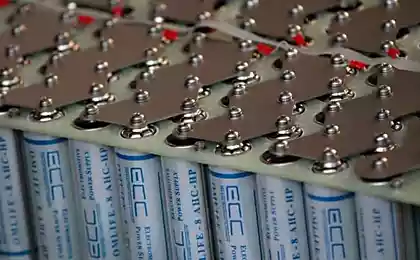396
Hybrid power supply system
The decline of traditional energy sources and the trend towards higher energy efficiency are forcing people to look for more and more sophisticated methods of using traditional and non-traditional energy sources. Hybrid power supply systems have recently become very popular. They include the use of various energy sources. Electrical energy is generated using solar photovoltaic panels, wind turbines, or other conversion systems.
The generation of thermal energy for heating systems, hot water supply and technological processes is carried out using solar collectors (flat and vacuum tubular), geothermal systems, as well as other heat energy converters. The combination of different renewable energy sources is not only the presence of elements such as solar collectors, photovoltaic panels, wind turbines, heat pumps, but also the use of a single control system to ensure the efficient operation of these elements, which forms the basis of a more stable hybrid power supply system.
For the efficient use of a hybrid power supply system using renewable energy sources, it is necessary to coordinate the intensity of the supply of different types of energy with the consumption of consumers on the basis of monitoring current information and management carried out by a single system based on microcontrollers or personal computers.
This article discusses the experience of creating hybrid power supply systems as a result of international cooperation between Polish and Ukrainian researchers in the field of renewable energy.
From the Polish side, a hybrid hot water supply system of the hotel complex was developed. The development was attended by employees of the Warsaw University of Life Sciences (SGGW) and the Lublin University of Technology.
This system was put into operation in 1998. This hybrid system uses electrical energy from the external grid, solar energy, geothermal energy and a gas boiler. The hybrid system is controlled and fully controlled by the Siemens PLC S7-300 controller in accordance with the developed operating algorithms.
The hybrid hot water supply system consists of several independent segments: flat and vacuum tubular collectors, a steam compression heat pump with a ground primary source of low-potential heat and a thermal storage tank with a volume of 2 m3. The scheme of such a system is presented in Fig. 1. The hybrid system also includes a gas boiler and electric water heaters, which provide thermal energy to the hotel complex in the event of a lack of energy from renewable sources.
Rice. 1. Hybrid heat supply system: vacuum tubular collectors with a total area of 6 m2; water storage tank with a capacity of 0.3 m3 with two heat exchangers; main storage reservoir for water with a capacity of 1 m3; main plate heat exchanger of a heat pump with a capacity of 12.5 kW; storage tank with a capacity of 2 m3; additional auxiliary heat storage tank; flat solar collectors with a total area of 40 m2; plate heat exchanger of solar collectors; ground vertical heat exchanger with a length of 360 m. Additional symbols denote: electricity meters, temperature and flow sensors, circulation pump, three-way valve, pyranometer. The flat solar collector segment (Figure 2) consists of 20 panels with a total sensing surface of 40 m2 of ground location with a stationary orientation to the south. It is used as the main heat source for hot water in a storage tank with a capacity of 1 m3 and auxiliary - 2 m3, which is used as an energy storage device from a heat pump.
Rice. 2. Solar segments in a hybrid system. Due to the use of glycol solution as a coolant in the solar system, hot water tanks are separated from solar collectors by plate heat exchangers.
The segment of vacuum tubular collectors based on heat pipes consists of 60 pipes with a total absorption surface of 6 m2. These collectors are mounted on the roof of the auxiliary housing, with an angle of inclination of 40° and a south-west orientation (Figure 2). This segment is connected to a 0.3 m3 battery tank with two internal heat exchangers, connected in series to a 1 m3 main battery tank. One of the heat exchangers is used to maintain temperature using a gas boiler.
The stochastic nature of solar radiation causes a significant variation in the volume of thermal energy production in collectors. This change applies either to specific hours in the daytime or on specific days of the week and season. To stabilize the production of thermal energy, a steam compression heat pump of a geothermal system with a nominal power of 12.5 kW with vertical ground probes is used.
The vertical ground heat exchanger is made using a polyethylene pipe with a diameter of 40 mm, made in the form of a double U-shaped loop installed in 6 wells with a depth of 30 m each. The total length of the pipeline is 360 m in the form of two parallel 180 m branches. The heat pump ensures the production of hot water with a temperature of 50 ° C.
As a reserve source of thermal energy, a gas boiler is used, which covers the lack of thermal energy in case of excess of the power consumption of the hot water supply system of the total power of solar collectors and a heat pump. In practice, this is observed only in the winter period of the year.
The described hybrid system is equipped with an extensive measuring system that provides information monitoring, which includes the constant recording of sensor readings in all nodes of the system, where conversion, transportation and heat exchange occur, as well as the creation of a database and knowledge. This database is used to perform short-term forecasts of the system. They can also be used to develop methods for diagnosing the energy efficiency of heat power systems. Control and regulation of the parameters of the hybrid system was carried out remotely using the Internet.
Solar radiation intensity is measured using two pyranometers for measurement in both planes of collectors: one for flat and one for tubular collectors. These pyranometers belong to ISO Class II, and their accuracy is sufficient for operational applications.
In 2011, the system underwent modernization, in particular, the measurement and control system was changed, interchangeable flow circulation pumps and controlled electromagnetic valves were installed (Figure 3).
Rice. 3. The scheme of control means of the modernized hybrid system: D - hand valves, E - electric valves, EP - three-way valve, P - circulation pumps. A single controller is used to control the entire system. It receives information directly from the controlled regulators and indirectly from the measuring sensors, from the current state of the external inputs (e.g. solar radiation, ambient temperature) and the current flow rate of hot water (Figure 4). It also performs data analysis and controls electromagnetic valves. The control algorithm can also be changed remotely (via the Internet).
Rice. 4. The modernized principle of hybrid system control. In addition, the upgraded system for the purpose of visualization and data storage uses SCADA software (WinCC), which is implemented in Windows on a personal computer. The computer communicates with the controller via the CP5611 Profibus card.
Rice. 5 shows the main screen interface of the updated system.
Rice. 5. The main screen interface for the updated monitoring system. The modernization of the system made it possible to carry out dynamic identification of all components of devices, to develop the correct algorithms of the system. The simulation results allow us to develop a convenient control algorithm that ensures minimal losses in the use of renewable energy sources.
Within the framework of bilateral cooperation between the universities of Poland and Ukraine, as well as to obtain a comparative assessment of the effectiveness of hybrid systems in different climatic conditions, a similar installation was implemented in the laboratory of renewable energy sources of the Department of Energy of Lviv National University in 2005.
The installation includes: a thermal solar hot water system, built on the basis of two flat collectors with a total area of 3.76 m2; a heat pump with a capacity of 15 kW of soil type with four horizontal collectors and two vertical probes with a well depth of 50 m; a wind power plant with a capacity of 5.7 kW; a photovoltaic plant with a capacity of 100 W, built on the basis of two photo panels, one of which was installed stationary, and the second on a rotary device with solar tracking.
The general view of the elements of the hybrid system developed and assembled in Lviv NAU is shown in Fig. 6.
Rice. 6. General type of components of the hybrid power supply system of the renewable energy laboratory. National Instruments hardware and software were used to monitor system operation, processing and storage, in particular the NI USB-6008 I/O unit and the LabVIEW software environment.
A fragment of the working window of the front panel and the program code (block diagram) of the monitoring system of the heat pump is shown in Fig. 7.
Rice. 7. Fragment of the working window of the front panel and the program code (block diagram) of the monitoring system for the heat pump. published by D. Voitsitsitska-Migasyuk, A. Khokhovsky, S. Sirotyuk
P.S. And remember, just changing our consumption – together we change the world!
Join us on Facebook and VKontakte, and we are also in Odnoklasniki
Source: alternativenergy.ru
The generation of thermal energy for heating systems, hot water supply and technological processes is carried out using solar collectors (flat and vacuum tubular), geothermal systems, as well as other heat energy converters. The combination of different renewable energy sources is not only the presence of elements such as solar collectors, photovoltaic panels, wind turbines, heat pumps, but also the use of a single control system to ensure the efficient operation of these elements, which forms the basis of a more stable hybrid power supply system.
For the efficient use of a hybrid power supply system using renewable energy sources, it is necessary to coordinate the intensity of the supply of different types of energy with the consumption of consumers on the basis of monitoring current information and management carried out by a single system based on microcontrollers or personal computers.
This article discusses the experience of creating hybrid power supply systems as a result of international cooperation between Polish and Ukrainian researchers in the field of renewable energy.
From the Polish side, a hybrid hot water supply system of the hotel complex was developed. The development was attended by employees of the Warsaw University of Life Sciences (SGGW) and the Lublin University of Technology.
This system was put into operation in 1998. This hybrid system uses electrical energy from the external grid, solar energy, geothermal energy and a gas boiler. The hybrid system is controlled and fully controlled by the Siemens PLC S7-300 controller in accordance with the developed operating algorithms.
The hybrid hot water supply system consists of several independent segments: flat and vacuum tubular collectors, a steam compression heat pump with a ground primary source of low-potential heat and a thermal storage tank with a volume of 2 m3. The scheme of such a system is presented in Fig. 1. The hybrid system also includes a gas boiler and electric water heaters, which provide thermal energy to the hotel complex in the event of a lack of energy from renewable sources.
Rice. 1. Hybrid heat supply system: vacuum tubular collectors with a total area of 6 m2; water storage tank with a capacity of 0.3 m3 with two heat exchangers; main storage reservoir for water with a capacity of 1 m3; main plate heat exchanger of a heat pump with a capacity of 12.5 kW; storage tank with a capacity of 2 m3; additional auxiliary heat storage tank; flat solar collectors with a total area of 40 m2; plate heat exchanger of solar collectors; ground vertical heat exchanger with a length of 360 m. Additional symbols denote: electricity meters, temperature and flow sensors, circulation pump, three-way valve, pyranometer. The flat solar collector segment (Figure 2) consists of 20 panels with a total sensing surface of 40 m2 of ground location with a stationary orientation to the south. It is used as the main heat source for hot water in a storage tank with a capacity of 1 m3 and auxiliary - 2 m3, which is used as an energy storage device from a heat pump.
Rice. 2. Solar segments in a hybrid system. Due to the use of glycol solution as a coolant in the solar system, hot water tanks are separated from solar collectors by plate heat exchangers.
The segment of vacuum tubular collectors based on heat pipes consists of 60 pipes with a total absorption surface of 6 m2. These collectors are mounted on the roof of the auxiliary housing, with an angle of inclination of 40° and a south-west orientation (Figure 2). This segment is connected to a 0.3 m3 battery tank with two internal heat exchangers, connected in series to a 1 m3 main battery tank. One of the heat exchangers is used to maintain temperature using a gas boiler.
The stochastic nature of solar radiation causes a significant variation in the volume of thermal energy production in collectors. This change applies either to specific hours in the daytime or on specific days of the week and season. To stabilize the production of thermal energy, a steam compression heat pump of a geothermal system with a nominal power of 12.5 kW with vertical ground probes is used.
The vertical ground heat exchanger is made using a polyethylene pipe with a diameter of 40 mm, made in the form of a double U-shaped loop installed in 6 wells with a depth of 30 m each. The total length of the pipeline is 360 m in the form of two parallel 180 m branches. The heat pump ensures the production of hot water with a temperature of 50 ° C.
As a reserve source of thermal energy, a gas boiler is used, which covers the lack of thermal energy in case of excess of the power consumption of the hot water supply system of the total power of solar collectors and a heat pump. In practice, this is observed only in the winter period of the year.
The described hybrid system is equipped with an extensive measuring system that provides information monitoring, which includes the constant recording of sensor readings in all nodes of the system, where conversion, transportation and heat exchange occur, as well as the creation of a database and knowledge. This database is used to perform short-term forecasts of the system. They can also be used to develop methods for diagnosing the energy efficiency of heat power systems. Control and regulation of the parameters of the hybrid system was carried out remotely using the Internet.
Solar radiation intensity is measured using two pyranometers for measurement in both planes of collectors: one for flat and one for tubular collectors. These pyranometers belong to ISO Class II, and their accuracy is sufficient for operational applications.
In 2011, the system underwent modernization, in particular, the measurement and control system was changed, interchangeable flow circulation pumps and controlled electromagnetic valves were installed (Figure 3).
Rice. 3. The scheme of control means of the modernized hybrid system: D - hand valves, E - electric valves, EP - three-way valve, P - circulation pumps. A single controller is used to control the entire system. It receives information directly from the controlled regulators and indirectly from the measuring sensors, from the current state of the external inputs (e.g. solar radiation, ambient temperature) and the current flow rate of hot water (Figure 4). It also performs data analysis and controls electromagnetic valves. The control algorithm can also be changed remotely (via the Internet).
Rice. 4. The modernized principle of hybrid system control. In addition, the upgraded system for the purpose of visualization and data storage uses SCADA software (WinCC), which is implemented in Windows on a personal computer. The computer communicates with the controller via the CP5611 Profibus card.
Rice. 5 shows the main screen interface of the updated system.
Rice. 5. The main screen interface for the updated monitoring system. The modernization of the system made it possible to carry out dynamic identification of all components of devices, to develop the correct algorithms of the system. The simulation results allow us to develop a convenient control algorithm that ensures minimal losses in the use of renewable energy sources.
Within the framework of bilateral cooperation between the universities of Poland and Ukraine, as well as to obtain a comparative assessment of the effectiveness of hybrid systems in different climatic conditions, a similar installation was implemented in the laboratory of renewable energy sources of the Department of Energy of Lviv National University in 2005.
The installation includes: a thermal solar hot water system, built on the basis of two flat collectors with a total area of 3.76 m2; a heat pump with a capacity of 15 kW of soil type with four horizontal collectors and two vertical probes with a well depth of 50 m; a wind power plant with a capacity of 5.7 kW; a photovoltaic plant with a capacity of 100 W, built on the basis of two photo panels, one of which was installed stationary, and the second on a rotary device with solar tracking.
The general view of the elements of the hybrid system developed and assembled in Lviv NAU is shown in Fig. 6.
Rice. 6. General type of components of the hybrid power supply system of the renewable energy laboratory. National Instruments hardware and software were used to monitor system operation, processing and storage, in particular the NI USB-6008 I/O unit and the LabVIEW software environment.
A fragment of the working window of the front panel and the program code (block diagram) of the monitoring system of the heat pump is shown in Fig. 7.
Rice. 7. Fragment of the working window of the front panel and the program code (block diagram) of the monitoring system for the heat pump. published by D. Voitsitsitska-Migasyuk, A. Khokhovsky, S. Sirotyuk
P.S. And remember, just changing our consumption – together we change the world!
Join us on Facebook and VKontakte, and we are also in Odnoklasniki
Source: alternativenergy.ru
Wash without soap - the process of healing the body
Signs of lack of vitamins and minerals in the body























